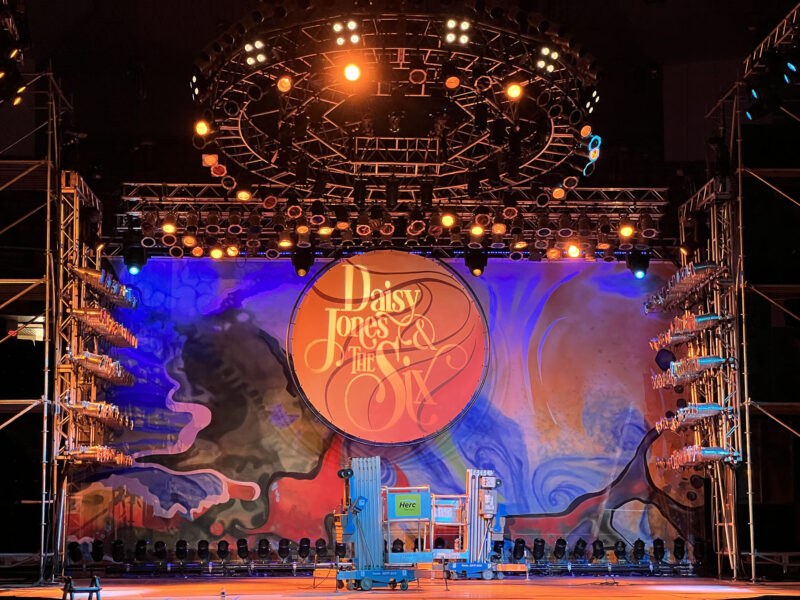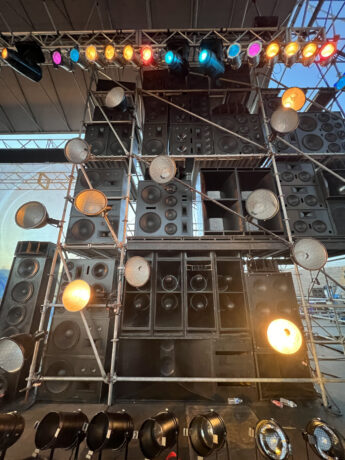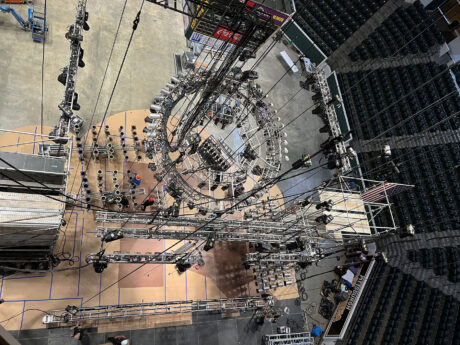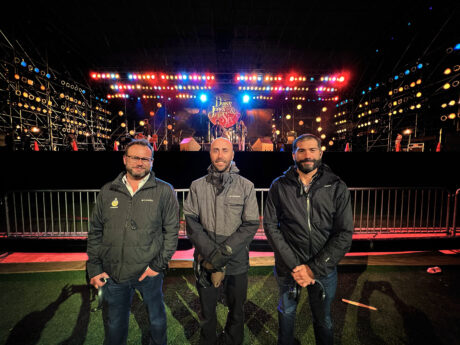
While not a single moving light source could actually appear on camera, Robe BMFLs, ESPRITES, and RoboSpots played a starring role for three different live concerts filmed for the live sections of the Amazon Prime hit Daisy Jones & The Six. A massive effort and meticulous detail went into crafting the vintage 1970s concert looks for the series by Lighting Director Matt Ardine, and while the hundreds of PAR cans visible at the gigs played their part in the visuality, for practicality, the band key lighting was achieved using Robe innovations.
 The pacey narrative follows a fictional rock band embroiled in the thrills and spills of the LA music scene, as Daisy Jones & The Six rise rapidly from obscurity to global fame and success, quitting unexpectedly at the height of their fame. Ardine was brought onboard by the series Gaffer, Nicholas Kaat, and the two of them worked with cinematographer Jeff Cutter to brainstorm design ideas for the four concert sections that featured throughout the 10-episode first season. These depicted a theatre, an arena, and a stadium show, all used for inserts as the series illustrated the band’s meteoric rise in popularity.
The pacey narrative follows a fictional rock band embroiled in the thrills and spills of the LA music scene, as Daisy Jones & The Six rise rapidly from obscurity to global fame and success, quitting unexpectedly at the height of their fame. Ardine was brought onboard by the series Gaffer, Nicholas Kaat, and the two of them worked with cinematographer Jeff Cutter to brainstorm design ideas for the four concert sections that featured throughout the 10-episode first season. These depicted a theatre, an arena, and a stadium show, all used for inserts as the series illustrated the band’s meteoric rise in popularity.
The ‘shows’ were filmed in four New Orleans locations – the historic Saenger Theatre, the Mahalia Jackson Theater of the Performing Arts, Tad Gormley Stadium, and the SLU (Southeastern Louisiana University) Center Arena. Each involved a slightly different lighting design based on similar themes. For speed, efficiency, and functionality during the filming of these scenes, up to 80 BMFL Spots and Blade moving lights were used to cover key lighting plus other essential illumination from the top and sides, chosen for their power and versatility.
Ardine undertook plenty of research before embarking on the project, studying films, videos and photos of the day, and the shows – and the series – were loosely based on rock icons c. Ardine even consulted Fleetwood Mac’s LD from back in the day, the legendary Curry Grant, and received a wealth of useful tips about how the stage would have looked and related to the technology they would have used.
Ardine enjoyed the educational aspects of this, and especially looking at Grant’s original lighting plots and patch lists which he dug out from his archives. “It was a completely invaluable resource,” Matt commented. Grant also gave them a heads up on how a light show would have been programmed and run, which would have been a very manual operation at the time. However, for the recording, this was done with a grandMA3.
Crafting a genuine looking period stage involved rigging the moving lights high up in the rig well out of shot and obscured with PAR cans arranged to allow a workable light path to the stage. The process was more complex than it sounds. Ardine closely studied elements like the colors that Grant had used and recreated them with the BMFLs. “I needed a very flexible light with a high-quality output and excellent color mixing for this” he elucidated.

Four RoboSpot systems were made available for each of the three concerts shoots by New Orleans based lighting contractor, RZI Lighting. These were running with Robe ESPRITES for the theatre / arena style shows and BMFL Blades for the stadium show… when they needed that bit of extra punch and throw. “I’m a huge fan of white light LEDs with CMY color mixing,” explained Ardine about the choice of ESPRITES, and he notes that the dimming curve is nicely smooth and there is also “no mechanical or color shift with them.”
BMFLs were also picked for their smooth dimming, which is vital for key lighting on camera, an art that Ardine has perfected whilst working on numerous high-profile live televised and streamed shows like I Heart Radio as well as on other movies, where he will often edit the lighting design specifically for the closeup cameras.
Based in LA, Ardine works on a plethora of broadcast concerts, TV shows, and commercials. He’s been a fan of the RoboSpot system since it was launched in 2016, admitting that he’s never really enjoyed calling spots, so the concept of telling the operator just to stay on the performer and controlling everything else via the console appealed from the offset. In a typical set up he will have a second console running the RoboSpot luminaires allowing him to react and tweak rapidly, especially the intensity, according to the needs of the shot.
For the Daisy Jones & The Six theatre shows, the ESPRITE FollowSpots were located at the FOH positions, relatively close to the stage to get the optimal angle on the band. Ardine has also used them in a similar way on comedy club shows where headroom is tight.
 He worked on the Daisy Jones & The Six project for approximately two and a half months, from pre-vizzing what was possible of the shows to wrapping the shoot at the last location – which was the first concert chronologically in the series. Ardine worked closely with Lighting Programmer and Operator David Kane who is also a drummer with a natural sense of rhythm and a film lighting specialist. The two met on their first day at Emerson College in 2002 and became great friends as well as working as a lighting / visuals team regularly ever since.
He worked on the Daisy Jones & The Six project for approximately two and a half months, from pre-vizzing what was possible of the shows to wrapping the shoot at the last location – which was the first concert chronologically in the series. Ardine worked closely with Lighting Programmer and Operator David Kane who is also a drummer with a natural sense of rhythm and a film lighting specialist. The two met on their first day at Emerson College in 2002 and became great friends as well as working as a lighting / visuals team regularly ever since.

Challenges for the outdoor concert filming included the inclement weather which yielded a tornado and plenty of rain, but none of that dampened enthusiasm for or enjoyment of the project, especially when they all started seeing how cool it looked and how seamlessly it translated on camera with the resulting authentic period feel. Kane commented, “Matt had a great overall vision about how the concerts should look, and I also had some creative freedom to contribute with ideas, so it was an excellent and very collaborative way to work.” He also relished the task of achieving a classic 1970s look using technology including some of Robe’s finest, from fifty years later.
Further information from Robe lighting: www.robe.cz
Photos: courtesy of Matt Ardine & His Crew


